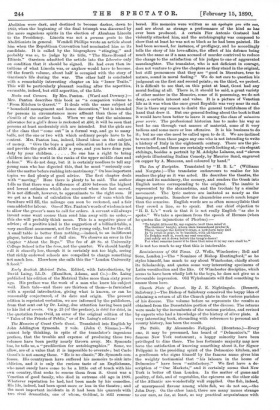Early Scottish Metrical Tales. Edited, with Introductions, by David Laing,
LL.D. (Hamilton, Adams, and Co.)—Dr. Laing published his edition of the Metrical Tales more than sixty years ago. His preface was the work of a man who knew his subject well. Each tale—and there are thirteen of them—is furnished with a special introduction, giving what is known, or can be reasonably conjectured, of its date and origin. The present edition is reprinted verbatim, we are informed by the publishers, from that sent out by Dr. Laing, due attention having been paid to his list of errata. On p. 25 (of the preface), is debit for debet, in the quotation from Ovid, an error of the original edition of the "Tales of the Priests of Peblis," or of Dr. Laing's edition ?
The Memoirs of Count Carlo Gozzi. Translated into English by John Addington Symonds. 2 vols. (John C. Nimmo.)—We cannot help thinking, in spite of the translator's ingenious preface, that the trouble and expense of producing these two volumes have been pretty nearly thrown away. Mr. Symonds has, he tells us, a "predilection for autobiographies." Some, we allow, are of a value that it is impossible to overrate ; but Carlo Gozzi's is not among these. "He is no classic," Mr. Symonds con- fesses. His countrymen have suffered his memoirs to sink into oblivion, and it is only the curious taste of an Englishman, who must surely have come to be a little out of touch with his own country, that seeks to rescue them from it. Gozzi was a Venetian of good family, who died in extreme old age in 1806. Whatever reputation he had, had been made by his comedies. His life, indeed, had been spent more or less in the theatre ; and the moat important incidents in it had been his quarrels with two rival dramatists, one of whom, Goldoni; is still remem- bered. His memoirs were written as an apologia pro vita sun, and are about as strange a performance of the kind as has ever been produced. A certain Pier Antonio Gratasol had violently attacked him, and the autobiography was composed to show that at least he was not so black as he had been painted. He had been accused, for instance, of profligacy, and he accordingly tells the story of his love-affairs, the effect of his defence being much the same as if a man accused of murder contrived to reduce the charge to the satisfaction of his judges to one of aggravated manslaughter. The translator, who is not deficient in courage, does not venture to give the chapters as they stand in the original, but still pronounces that they are "good in literature, true to nature, sound in moral feeling." We do not care to question his judgment on the first and second points ; on the third, we protest. It is difficult to see that, on this point at least, Gozzi had any moral feeling at all. There is, it should be said, a great variety of other matter in the Memoirs, some of it possessing, we do not deny, a certain interest and value. It is a picture of Venetian life as it was when the once great Republic was very near its end. Nor is there any reason to doubt the general truthfulness of the hand that drew it. But our general feeling about the book is that it would have been better to leave it among the class of ?IV-moues pour servir. The professional historian has to make his way as best he can through vast masses of material, some of it very tedious and some more or less offensive. It is his business to do it; but no one else need be called upon to do it. We are inclined to warn-off from these pages any one who is not intending to write a history of Italy in the eighteenth century. There are the pic- tures indeed, and these are certainly worth looking at,—six elegant etchings, besides a portrait by M. Adolphe Lalauze, and "eleven subjects illustrating Italian Comedy, by Maurice Sand, engraved. on copper by A. lIttanceau, and coloured by hand."


































 Previous page
Previous page